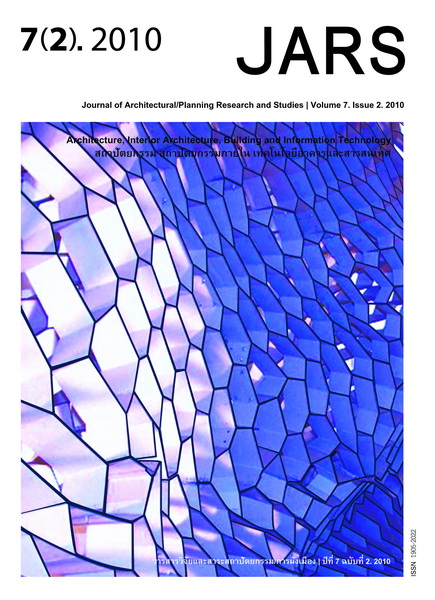Transformation of Waste Plastic Bottles into Covered Parking
Main Article Content
Abstract
One of the environmental problems that we have witnessed nowadays comes from the increased volume
of garbage. Each year, Thailand generates up to 13.9 million tons of waste which includes plastic packaging
and waste material that have a potential to be reused roughly 6 million tons but there is only 2 million
tons or 14.4 percent of such reuseable waste being reused. The solution of recycling and reuse could be an
alternative approach to create or increase the value of wasted material.
Under these circumstances, this research aims at exploring the ways to transform plastic water bottle
waste into architectural elements, specifically a roof of covered parking. The prototype was created based on
the morphology theory. The result of this design was generated and evaluated with 3D Studio Max program,
a computer program that can simulate materials and lighting conditions.
The outcomes of this study indicate that the prototype could reduce an amount of radiation penetration
with the same level as a light filter, but there are two concerning points which are the maintenance
and the cost of the prototype. However, this research could be an example of the architecture that
addresses the environmental degradation.
Downloads
Article Details

This work is licensed under a Creative Commons Attribution-NonCommercial-NoDerivatives 4.0 International License.
All material is licensed under the terms of the Creative Commons Attribution 4.0 International (CC-BY-NC-ND 4.0) License, unless otherwise stated. As such, authors are free to share, copy, and redistribute the material in any medium or format. The authors must give appropriate credit, provide a link to the license, and indicate if changes were made. The authors may do so in any reasonable manner, but not in any way that suggests the licensor endorses you or your use. The authors may not use the material for commercial purposes. If the authors remix, transform, or build upon the material, they may not distribute the modified material, unless permission is obtained from JARS. Final, accepted versions of the paper may be posted on third party repositories, provided appropriate acknowledgement to the original source is clearly noted.
References
Chinsirikul, W. (2001). พลาสติกนวัตกรรมแห่งสหัสวรรษ [Plastic: The innovation of the millenium]. In MTEC, ความรู้เบื้องต้นด้านวัสดุ [Introduction to metals, ceramics and polymers]. Bangkok, Thailand: National Metal and Materials Technology Center, 61.
Evans, D., & Ross, S. (2003). The environmental effect of reusing and recycling a plastic-based packaging system. Journal of Cleaner Production, 11(5), 561-571.
Jira-Arun, N. (2003). ธุรกิจอนาคต พลาสติกรีไซเคิล [The future business in plastic recycle]. Journal of Plastic and Environment, 3(21), 12.
Leejarkpai, T. (2006). รีไซเคิลพลาสติก [Recycle plastic]. Bangkok, Thailand: National Metal and Materials Technology Center.
Ljungberg, L. Y. (2007). Materials selection and design for development of sustainable products. Materials & Design, 28(2), 466-479.
Pearce, P. (1990). Structure in nature is a strategy for design. Massachusetts: The MIT Press.
Tank, F. (2007). Against the grain: Crafting the complex surface. Praxis: Expanding Surface.
Thai Prasit Textile. (2009). Woven plastic mesh: HDPE shading net. Retrieved April 20, 2009, from http://www.thailandmesh.com/th_wpm_shadingnet.htm
Wongpanit. (2009). Pricing and ordering. Retrieved April 20, 2009, from http://www.wongpanit.com/pri.pdf


